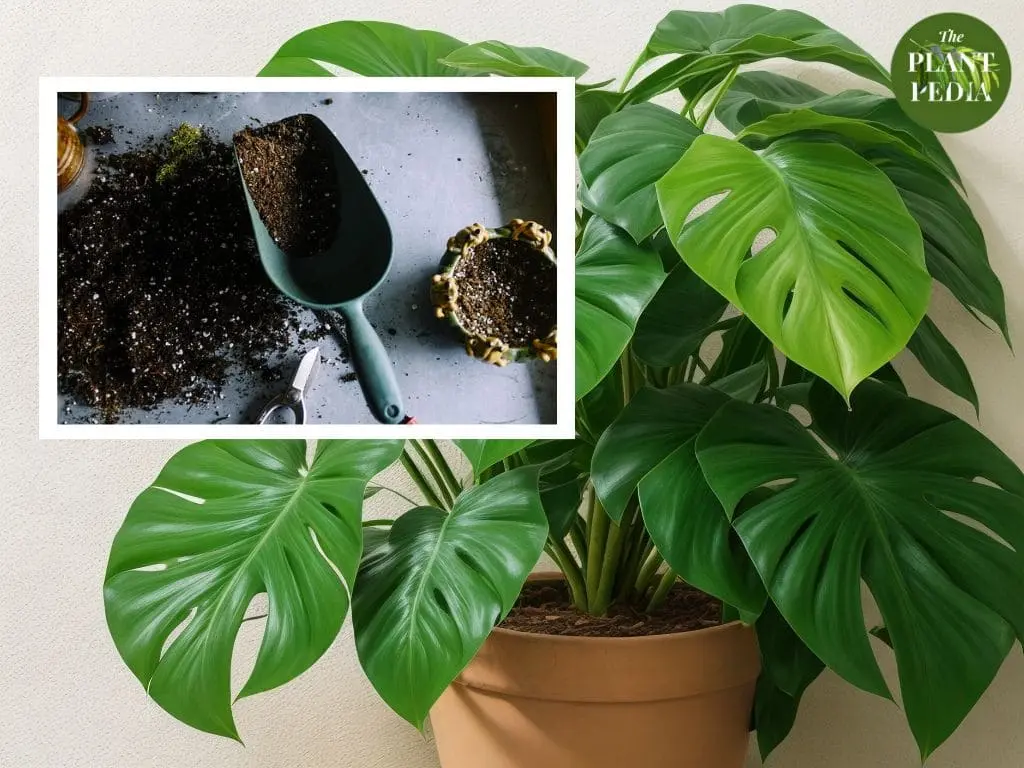Creating an ideal environment for your beloved Monstera plant involves many considerations, and one of the most critical factors is the soil it grows in.
Monstera deliciosa, popularly known as the Swiss cheese plant due to its unique fenestrated leaves, is an iconic choice among houseplant enthusiasts for its striking appearance and relatively easy care requirements.
However, to ensure your Monstera thrives, understanding the significance of the soil it resides in is paramount.

Unveiling the Monstera Plant: A Brief Introduction
Before delving into the nuances of Monstera plant soil, let’s take a moment to appreciate this tropical beauty.
Originating from the rainforests of Central and South America, Monstera deliciosa boasts large, glossy leaves characterized by their intriguing splits and holes.
This plant has become a staple in interior décor due to its ability to add a touch of the exotic to any space.
Monstera Soil Mix Recipe: Step-by-Step Guide
Crafting the perfect soil mix for your Monstera plant involves a thoughtful combination of various components to ensure optimal growth conditions.
Follow these steps to create a well-balanced soil mix for your Monstera:
1. Gather the Necessary Components:
Collect the essential ingredients required for creating the soil mix. These commonly include:
- Potting Soil: Select a high-quality potting mix as the base for your soil. Ensure it’s well-draining and free from pests or diseases.
- Perlite or Pumice: These materials enhance drainage and aeration in the soil mix. Aim for a ratio of about 1:1 with the potting soil.
- Organic Matter (Peat Moss or Coconut Coir): Choose either peat moss or coconut coir to improve moisture retention and contribute to the soil’s structure. Maintain a ratio of approximately 1:1 with the potting soil.
- Optional Additives (Orchid Bark, Worm Castings, or Compost): Depending on availability and preference, consider adding orchid bark, worm castings, or compost to boost nutrients and soil health.
2. Prepare the Soil Mix:
Combine the components in a large container or bucket in the specified ratios. Thoroughly mix them together to ensure an even distribution of each ingredient.
This step is crucial for creating a well-balanced soil mix that provides adequate drainage, aeration, and nutrient retention.
3. Adjust Consistency as Needed:
Check the consistency of the soil mix. It should feel crumbly and well-aerated while retaining some moisture.
If the mix seems too dense or compact, add more perlite or pumice to improve aeration.
Conversely, if it feels too loose, increase the amount of peat moss or coconut coir to enhance moisture retention.
4. Fill the Plant Pot:
Select a clean pot with drainage holes at the bottom to allow excess water to escape. Fill the pot with the prepared soil mix, leaving enough space at the top for watering and to prevent overflow.
5. Plant Your Monstera:
Carefully transplant your Monstera into the newly filled pot, ensuring the roots are spread evenly within the soil mix.
Gently pat down the soil around the plant to secure it in place.
6. Water Appropriately:
After planting, give your Monstera a thorough watering to help settle the soil around the roots.
Ensure that excess water drains freely from the pot, preventing waterlogging.
By following these steps, you’ll create a well-balanced soil mix tailored to meet the specific needs of your Monstera plant, setting the foundation for its healthy growth and development.
Read: 10 Best Soil for Monstera Plants: Which Potting Mix is Best?
The Role of Soil in Monstera Plant Health
The soil is not merely a medium for the plant’s roots to anchor themselves; it serves as a crucial supplier of nutrients, water, and oxygen essential for healthy growth.
The right soil composition can significantly impact the overall well-being of your Monstera plant.
Read: Does Monstera Like Humidity?
Understanding Ideal Soil Composition for Monstera Plants
Creating the perfect soil mix for your Monstera involves achieving a delicate balance of various components to mimic its natural habitat.
Here are the key elements to consider:
1. Well-Draining Medium:
Monstera plants despise soggy roots and are prone to root rot if left in waterlogged soil.
Hence, the soil mix should have excellent drainage to prevent excess water retention.
A combination of perlite, pumice, or coarse sand helps enhance drainage and aeration.
2. Organic Matter:
Organic components such as peat moss, coconut coir, or compost provide essential nutrients and retain moisture without becoming overly compacted.
This organic matter acts as a reservoir for moisture while allowing excess water to drain away.
3. Aeration:
Aeration is vital for healthy root development. Including materials like perlite or orchid bark in the soil mix creates air pockets, facilitating oxygen flow to the roots.
4. Nutrient Content:
While Monstera plants are relatively forgiving when it comes to soil fertility, they still require adequate nutrients to thrive.
Using a balanced, slow-release fertilizer or supplementing the soil mix with organic matter ensures a steady supply of nutrients for sustained growth.
Best Soil Mix for Monstera Plants
A popular and effective soil mix for Monstera plants can be achieved by combining the following components:
- Potting Soil: A high-quality, well-draining potting mix serves as the base.
- Perlite: Enhances drainage and aeration.
- Peat Moss or Coconut Coir: Provides moisture retention and contributes to the soil’s structure.
- Orchid Bark or Pumice: Helps maintain aeration and prevents compaction.
- Worm Castings or Compost: Adds nutrients and promotes overall soil health.
Maintaining Monstera Plant Soil
Ensuring the longevity of your Monstera plant involves not just the initial potting but also ongoing soil maintenance.
Here are some tips to keep the soil in optimal condition:
1. Regular Inspections:
Check the soil moisture levels by inserting your finger about an inch deep into the soil. Water your Monstera only when the top inch of soil feels dry.
2. Repotting:
As Monstera plants grow, they might outgrow their current pots. Repotting every couple of years or when the plant seems root-bound allows for fresh soil and more space for root expansion.
3. Fertilization:
Feed your Monstera plant with a balanced fertilizer during the growing season (spring and summer) to provide essential nutrients for healthy foliage and growth.
4. Soil Aeration:
Gently aerate the soil by loosening it around the plant’s base to promote better air circulation and prevent compaction.
Conclusion
The soil in which your Monstera plant resides plays a pivotal role in its overall health and growth.
By creating a well-balanced, well-draining soil mix and practicing proper soil maintenance, you can ensure your Monstera thrives and continues to grace your space with its majestic foliage for years to come.
Understanding the importance of soil and providing the optimal growing conditions will reward you with a flourishing and vibrant Monstera plant that captures attention and admiration.
Remember, while soil is critical, other factors such as light, humidity, and temperature also contribute to the overall well-being of your Monstera.
Paying attention to these factors collectively will help create an ideal environment for your beloved plant to flourish.
